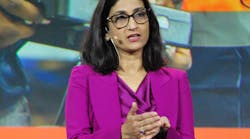Just as past events and behaviors are good indications of the future, Emerson’s long history of innovation is good evidence that more is on the way.
“I’ve gained many perspectives over 25 years with Emerson from operations to services, and most recently with emerging markets, so I know that we co-create with our end users every day,” said
Vidya Ramnath, senior VP and chief marketing officer at Emerson. “Innovation begins with customers and mindfully listening to them, and deeply considering their voice to find the pathways and innovations.”
Nathan Pettus, president of process systems and software at Emerson, added that, “Innovation is critical to the combined success of our customers and ourselves. Together, we are the stewards of the process industries.” But, he added, innovations that can really move the needle and change the world are difficult and rare, requiring both collaboration and domain expertise on both sides.
Ramnath and Pettus delivered the second-day keynote at Emerson Exchange Immerse this week in Anaheim, Calif.
A history of innovation
Ramnath reported that historic innovations inspired and driven by Emerson’s customers in recent decades include greater use of microprocessor-based instruments and DCSs, and open standards for fieldbus and wireless instrumentation protocols. “Emerson Fisher-Rosemount was one of the first automation companies to take a chance on general -purpose microprocessors and Microsoft software when many people thought such tools were just toys,” explained Pettus. “And now, everyone uses some kind of commercial, off-the-shelf product.”
Even as computing and software made other inroads, Ramnath added they’ve also moved out to the field and up to cloud services, where users can interact with them to further enable plant productivity and reliability. “We jumped in to pioneer smart devices that could measure flow, pressure, vibration and corrosion, and gathered diverse groups to develop and transform protocols like HART, Foundation Fieldbus and WirelessHART into industry standards,” said Ramnath.
“Emerson has long supported open, non-proprietary standards, so that everyone can use them,” Ramnath continued. “Whether it’s conveyed via wires or wireless, users always need data to support their analytics, better decisions and improved performance. Working together, we’ve always persevered, and that gives us the energy for whatever lies ahead. The best is yet to come.”
Presence in the present
Extending its tradition of innovations at Emerson Exchange Immerse this week, Pettus and Ramnath highlighted the company’s vision for Boundless Automation. This software-defined, data-centric, flexible, automation platform consists of a simple architecture that enables operational excellence by removing former obstacles. Its main features in the field, edge and cloud include:
• Cohesive software platform,
• Spans cloud, edge and field,
• Democratizes data,
• Holistic security,
• Broad interoperability,
• Extensibility for innovation, and
• Unlimited scalability.
“Even though Emerson came up with capabilities like electronic marshalling, today’s challenges to productivity and sustainability are driven by macro forces that require even more innovative solutions,” said Ramnath. “Today, users have to do even more with even less. Plus, they have net-zero goals, and many infrastructures aren’t ready. Emerson lives these same realities every day, too.” The good news is that Boundless Automation and the Emerson innovation it represents can help users maintain productivity and profitability without sacrificing sustainability.
Pettus added that Emerson is focused on developing the inspiration and purpose that can solve today’s problems, along with the tools required to achieve these goals in reality. For example, Emerson has launched DeltaV IO.Connect, which can seamlessly integrate its DeltaV automation system with legacy devices, such as Honeywell TDC3000 or other third-party I/O modules, substantially cutting modernization costs. Likewise, the company is pursuing Ethernet-APL communications technology to safely extend the reach of high-performance Ethernet into the field.
“This all starts with Boundless Automation that can access oceans of data, including information that used to be stranded,” said Ramnath. “Reaching devices out in the field is still vital, and whether it’s Ethernet-APL or upcoming 5G, we can reach them faster and cheaper, form cohesive links from the edge to the cloud, and provide the data and semi-autonomous systems that users need to optimize their processes.”



